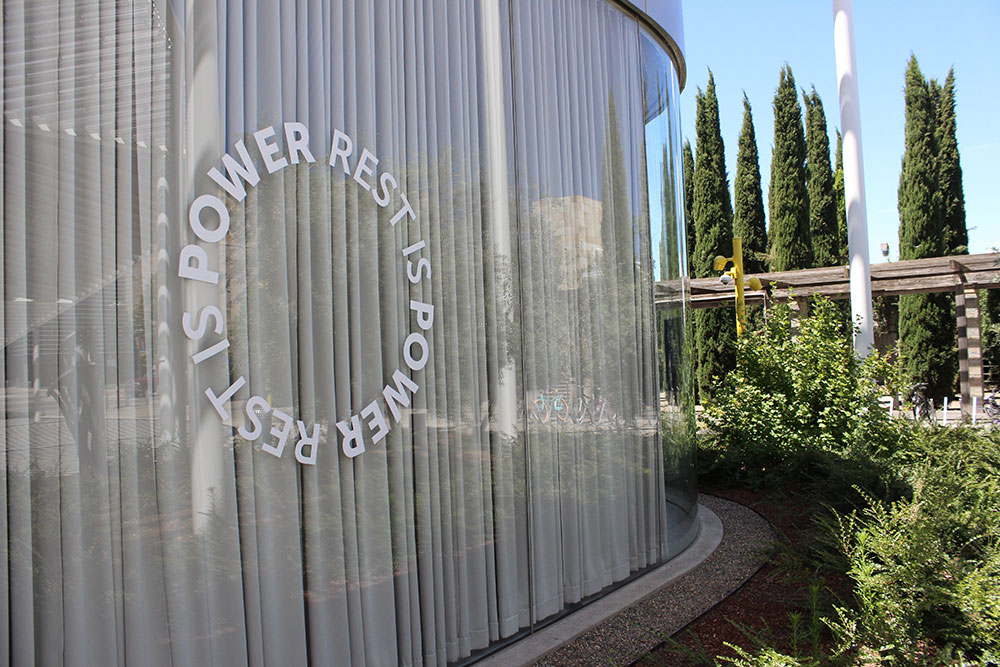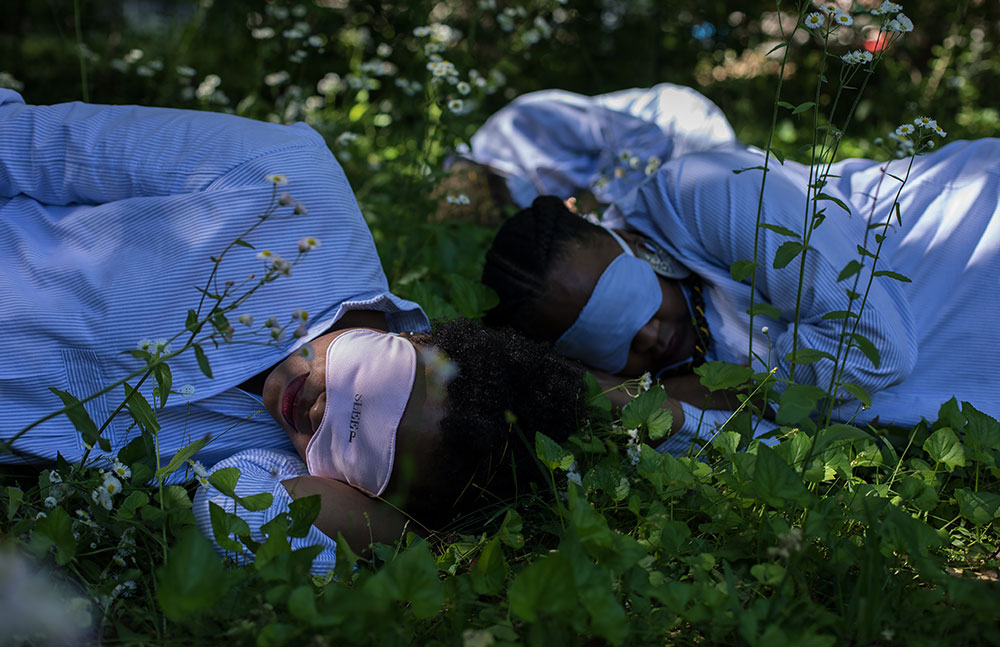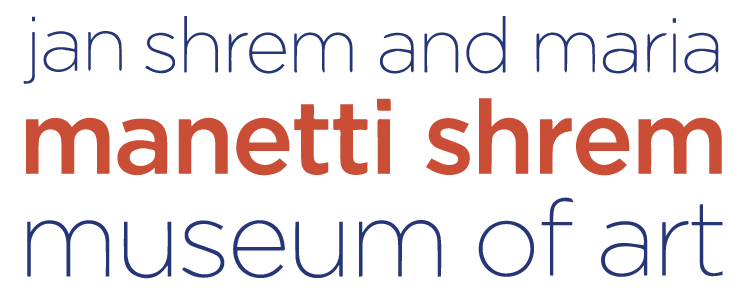Rest in Power, George Floyd
Rest in Power, George Floyd
By Susette Min
This essay introduces a student exhibition that was mounted last quarter right before the call to shelter in place took effect. I wrote the essay on the day after George Floyd’s life was taken away from him by four police officers. In light of what happened, the outcry and wave of global protests over the murder of George Floyd, I thought it fitting to add the following reflection on this new turn of events in relation to the exhibition, Rest is Power.
At a moment when the protests have continued quietly and peacefully, I’ve noticed a different kind of quiet has taken over — one distinguished from the slow days of sheltering in place. When I mentioned the “calm before the storm” in the first iteration of this essay below, I was primarily thinking about the human collateral damage and sacrificing of human lives in the state’s rush to open and restart the economy. Rather than passing stimulus legislation to boost a depressed economy, the talk back then (two weeks ago) of implementing more austerity measures was alarming, as such measures since 2008 have led to the woeful lack of infrastructure and preparedness to fight COVID-19, and created a growing precariat who are underpaid and overworked or underemployed and uninsured. Now the calm before the storm is something else, a feeling of hope instead of decimation, but also a sense of disquiet and apprehension.
Aside from the ramped-up use of force by the office of the president, this disquieting feeling also stems from a worry over burnout and protest fatigue. Over the past week and a half in streaming videos, news interviews, Instagram sit-downs, informal teach-ins and protest speeches, I’ve noticed that a number of Black activists — young and old — have expressed how utterly exhausted and tired they are. It’s impossible to imagine what it’s like to live daily in fear of white aggression and police brutality unless one has experienced and lived it. Impossible to imagine, too, the toll of this anxiety on one’s sleeping patterns, compounded by the need to mourn another senseless death again and again alongside the cumulative effects of trauma, outrage and betrayal about being Black in America and on this campus.
We are at the threshold of collective reckoning and state retribution, and it is our task for those who are not Black to not cave into protest fatigue, but to carve a space of rest and refuge for ourselves but especially for individuals who have for so long, and over the past two weeks, expended energy and time in resetting the world right and releasing it and us from the bondage of destructive ideologies and structures. We can do much in amplifying demands for example of Black Lives Matter (BLM), but also on the other end of the spectrum, we can also create quiet spaces of contemplation and mindfulness, rest and restoration.
Rest is a tool of revolution and a right. In order to sustain the momentum of this possible revolution, we need to be mindful that we are still in the middle of a pandemic …
* * *

Introduction to the Exhibition Rest is Power
The current pandemic has forced us to socially distance and physically isolate ourselves as a necessary measure to save lives. Without the obligation to commute to work or get to A or B or C due to the cancellation of meetings, trips, games and events, the pandemic has by default given some individuals a windfall of “extra time” to self-improve and/or be with family.
Over the past couple of months, there have been a number of upbeat stories about how to spend one’s time while sheltering in place, including engaging in DIY projects around the home and/or channeling Henry David Thoreau, who self-isolated at Walden Pond and pursued a course in self-education. Other articles have warned against such distractions and of “wasting” time by offering time management tips on how to make one’s home office a more comfortable and ergonomic workplace. As a rebuke to these go-getter articles, there has also been an array of op-eds about the need to resist the pressure to be productive and “be OK with just being.” The writers of these missives reassure us that it’s all right for us to be distracted and feel distress, recommending the need for self-care and forgiveness. This latter phenomenon of condoning “non-productivity” and slamming the brakes on the compulsive need to self-optimize and work 24/7 reveal not only a burnt-out culture, but also fatigue cracks underpinning a dysfunctional state.
It’s wishful thinking to perceive the need to stop conducting business and life as usual not just as a break, but as a reverberating death knell for neoliberal capitalism. Unfortunately, we are experiencing the calm before the storm. The need to open up the country in order to get the economy running again — in which we are left to our own devices to be individually responsible about socially distancing, our healthcare and well-being — are manipulations of time or what Elizabeth Freeman describes as “chrononormativity.” The decree to resume life as usual despite feelings of growing anxiety and uncertainty bind us to a set of desperate measures that covers over a failing and unfair system as well as compounds a long-standing pandemic preceding COVID-19: chronic sleep loss.
Shortly before campus closures and the mandate to shelter in place, a group of extraordinary students curated Rest is Power, an exhibition about how rest has been historically denied to black and brown, disabled and queer bodies. Sleep deprivation is a form of power that subjects bodies to keep up with the daily grind and tempo of capitalism. As many have already acknowledged — and statistics have reinforced — the coronavirus has revealed the widening gap among different groups of people. While the pandemic has upended our lives, for many, there has been no rest for the weary and no time to cope or grieve our altered world or life before the coronavirus. Already living lives in chronic crisis before the lockdown, the loss of jobs and/or cut in hours for hourly wage earners have been catastrophic. Other “essential” wage workers have been forced to labor in unsafe conditions or work until they get sick, a situation in which they are seen as worthy only if they can work, and where they can only find quietude, until they rest in peace.

Rest is Power is incredibly timely, as it brings to the fore how sleep is a racial and social justice issue and advances the idea that rest is an imperative means for restoration, recuperation and resistance. Much of the contemporary art selections by Sophia-Yemisi Adeyemo-Ross, Samantha Maria Xochitl Espinoza, Shannon Finnegan, Tricia Hersey, Malaya Tuyay and Charlie Watts re-present what rest looks like by rendering racialized and marginalized bodies resting in solitude and in shared spaces.
In correspondence with the exhibition, Hersey’s Rest is Resistance movement goes beyond a mantra that we need to set aside time for a nap. The Nap Ministry’s gospel is a call for trans-historical solidarity and guidance to help create a safe collective space to rest and dream; a means to heal and herald someday soon, a world liberated from white supremacy, patriarchy and capitalism.
Rest is productive.
Rest is empowering.

For those who are out of work with plenty of time on their hands, it must be recognized how being able to rest is more of a challenging task than ever. The pandemic has reasserted the historic need to counteract the forces of power in order to break the cycle of capitalism’s orbit. Drawing from a wide range of resources including Black liberation theology, science of sleep and Afro-futurism, Hersey’s gospel rearticulates the terms of political struggle and communal action by way of encouraging the need for us to see rest as reparations and resistance.
The portal to rest and dream, center oneself and rejuvenate, is threatening to come to a close. The curators — Heidi Herrera, Rita Huang, Micaella Sanchez, Abby Robertson and Alexandra Thoits — invite us to join Hersey and the other artists in the exhibition to step out of the linearity of straight time in order to create space and imagine new forms of social justice including the right to sleep for all.
Note, while the tone of this essay is one of agitation, Rest is Power is on the contrary measured, nuanced and supple, in its historical and contemporary presentation and exploration of sleep and sleep deprivation. The exhibition opens up time and makes accessible shared spaces to lounge, contemplate and make connections, and also to unplug, close one’s eyes and dream.
Susette Min is associate professor of Asian American studies and an affiliated faculty member in the Department of Art and Art History at UC Davis. Prior to joining UC Davis, Min was associate curator of contemporary art at The Drawing Center in New York City and has curated exhibitions at the Whitney Museum of American Art, the Asia Society, Blaffer Art Museum and the Los Angeles Municipal Art Gallery.
